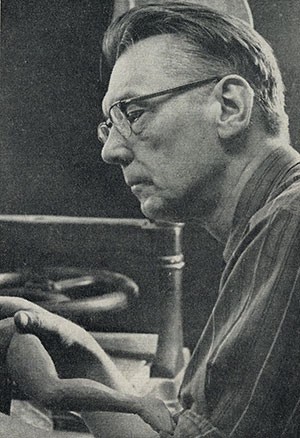Born 1909, Chicago, Illinois
Died 1992, Boston, Massachusetts
In many ways, Morton Bartlett’s art responded to his early loss of his family. Orphaned as a child and adopted by an upper-crust Boston couple, Bartlett attended Phillips Exeter Academy and Harvard College for two years, then dropped out and began to earn a living, primarily as a commercial photographer. It was in 1936 that, without friends’ or relatives’ knowledge, he initiated a hobby that consumed his spare time for almost thirty years. Studying medical manuals and books on the history of costume and photography, Bartlett learned to make plaster casts of anatomically precise dolls, at half life-size, which he painted and dressed in intricate clothing that he sewed himself. The ultimate creative act came when he photographed them in everyday scenes or posed in a dramatically illuminated studio. Bartlett worked privately, never intending to sell or exhibit his works. When a 1962 magazine article brought unwelcome interest from readers, the reclusive artist packed away his sculptures and related photographs, which remained hidden until after his death.
Bartlett’s exacting manufacture meant that he sometimes spent an entire year on a single figure, producing only fifteen dolls in the course of his career, along with some two hundred black-and-white photographs that transcend the documentary. Shot from multiple angles and under varying lighting conditions, employing different costumes and wigs, the photographs animate their referents by a twofold operation: they help create a distance that masks the dolls’ artificiality while imbuing them with personalities and moods that unfold over time. In one series focused on a prepubescent girl, Bartlett balanced his doll on her out-turned left foot, poised to take flight. In several shots she acts the ballerina, wearing a diamond tiara, long dress, or tutu; in others, she models a bikini, a bonnet, even a seductively thin black veil.
That film-inspired photographers Cindy Sherman and Laurie Simmons both own Bartlett’s prints attests to his resonance with what photo critic A. D. Coleman has termed the “directorial mode” of staged narratives featuring a glamorous female subject and focusing on identity construction, sexual awakening, and gender formation.
Kara Fiedorek
Harris, Marion. Family Found: The Lifetime Obsession of Morton Bartlett. New York: Marion Harris, 2002.
Kittelmann, Udo, and Claudia Dichter, eds. Morton Bartlett: Secret Universe 3. Cologne: Walter König, 2012.
